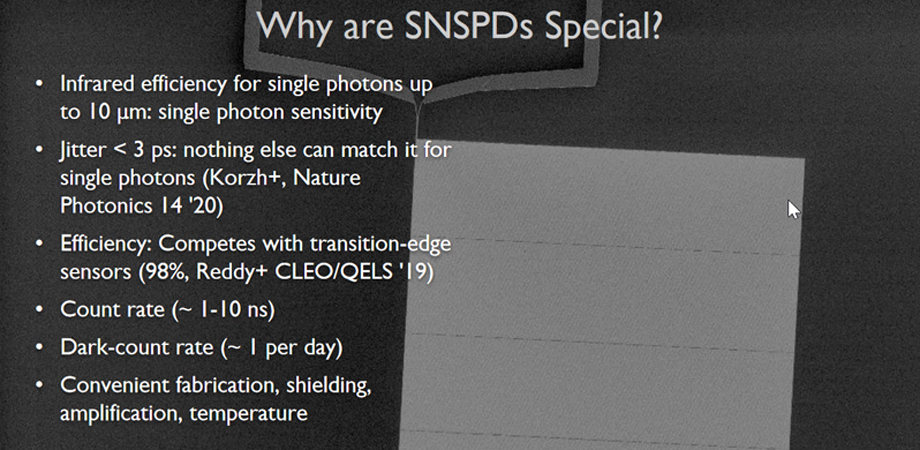Just what makes superconducting nanowire single-photon detectors so special?

 “I'm personally fascinated by the physics of how superconducting nanowire single-photon detectors (SNSPDs) work, and how that informs their capabilities,” says Karl Berggren, professor in MIT's department of Electrical Engineering and Computer Science. “When a detector fires, it generates a lot of heat that has to be dissipated, which takes time. It also generates microwave signals that bounce around the device and can affect the readout. Also, the design of the electromagnetics around it can influence the absorption of the light in the nanowire.”
“I'm personally fascinated by the physics of how superconducting nanowire single-photon detectors (SNSPDs) work, and how that informs their capabilities,” says Karl Berggren, professor in MIT's department of Electrical Engineering and Computer Science. “When a detector fires, it generates a lot of heat that has to be dissipated, which takes time. It also generates microwave signals that bounce around the device and can affect the readout. Also, the design of the electromagnetics around it can influence the absorption of the light in the nanowire.”
Berggren will be giving a plenary talk on SNSPDs at SPIE Defense + Commercial Sensing in April where he hopes to “sneak in a bit of the surprising science behind their operation, while also talking about the applications and importance of the detectors to the defense community. For example, microwave signals travel extremely slowly in these materials, as slowly as only 1% of the speed of light. That means we can fabricate some pretty complex microwave circuits in a pretty small package using these materials.”
What are some of the uses for SNSPDs
Currently, the largest demand for these devices seems to be in the field of quantum information, where they are important for their ability to detect the time of arrival of single infrared photons with high efficiency. Quantum communication relies on single photons to transmit information, so you have to be able to sense single photons efficiently in order to have fully take advantage of the quantum properties of the light. However, in research demonstrations they have been used for space communications, evaluation of very large-scale integration (VLSI) circuits, and lidar among other applications.
You also head the Quantum Nanostructures and Nanofabrication Group at MIT and are director of the Nanostructures Laboratory in the Research Laboratory of Electronics. Is there a particular project taking place in the group or lab that you’re most excited about?
We are part of the DARPA Invisible Headlights program that seeks to make imaging arrays of mid-infrared nanowire detectors for autonomous driving in the dark without illumination. It's a challenging program because the sensors have to be very fast and very sensitive in the mid-infrared.
We’ve been working to try to develop architectures for imaging arrays as well as electronics that could be used to read out the detectors. These detectors are fast and as a result you generate a huge amount of data with an imaging array. Figuring out how to best process that data is a major challenge, and one we’re excited about facing.
What do you see as the future for SNSPDs?
I think we've really only scratched the surface of what these devices can do. I can see them impacting the fields of medicine, high-energy physics, astronomy, and even environmental sensing. I expect that we'll soon see arrays of these devices in spectrometers and imagers, maybe even at far-infrared wavelengths. That would be something.
| Enjoy this article? Get similar news in your inbox |
|



